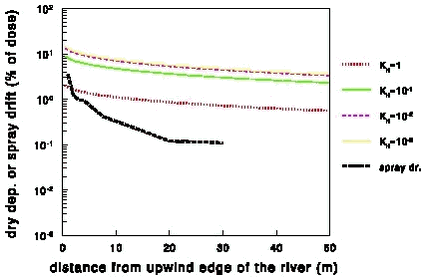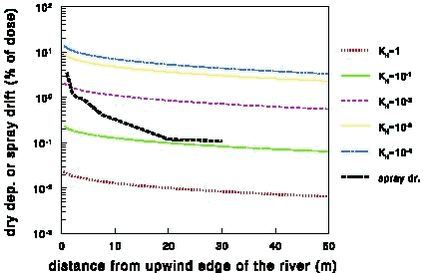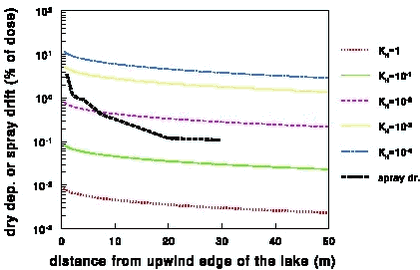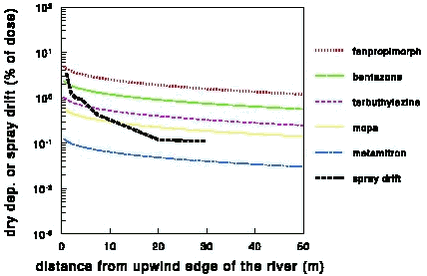Dry deposition and spray drift of pesticides to nearby water bodies
5 Discussion and conclusions5.1 General comparison dry deposition and spray drift5.2 Comparison for pesticides that are used in Denmark In this section the (potential) contribution from dry deposition to water bodies will be compared with the contribution from spray drift. 5.1 General comparison dry deposition and spray driftAlthough spray drift to some extent depends on the properties of the additives the 95% percentile from Ganzelmeier et al. (1995) is here used for all pesticides in the comparison with the modelled dry deposition (see Table 6). The dry deposition of pesticides depends on many factors: the physico-chemical properties of the pesticides, the meteorological conditions and the properties of the water body. The following situation was chosen for all dry deposition calculations presented here:
The calculations have been made for 3 different types of water bodies:
For all these types of water bodies calculations have been made for 6 different values of Henry’s law coefficients KH and a molecular mass of 300 g mol-1, which is representative for pesticides. The calculations have been made for a situation where 100% of the amount of pesticide volatilises. The results are presented in Figs. 32-34. The scales in all figures are the same so that a comparison is easily possible. If, however, only a fraction f of the pesticide volatilises the values for the dry deposition in the figures have to be multiplied by this fraction. This means that the dry deposition in that case will be reduced. This is done to make a generalisation possible. It should be noted that the spray drift is not affected by the volatilisation.
Figure 32. Dry deposition of pesticides to a stream with a low rc for different Henry’s law coefficients and spray drift as a function of the distance to the upwind edge of the stream. Only results for KH values of 100 to 10-3 are shown. In the calculations it is assumed that 100% of the pesticide volatilises. If only a fraction f of the applied pesticide volatilises the dry deposition in the figure has to be multiplied by a factor f. Figs. 32-34 show that dry deposition to water bodies potentially can be more important than spray drift, especially for streams. Whether it is more important depends e.g. on the fraction of the pesticides that volatilises and the Henry’s law coefficient. It can be seen that the results are the same for compounds with a Henry’s law coefficient of 10-4 and lower. In that case the deposition flux is limited by the laminar boundary layer resistance only and does not any longer depend on the properties of the water body. Figs. 32-34 show clearly that the relative decrease in the spray drift as a function of distance from the emission field is much larger than for dry deposition. Although the dry deposition model has been based on the description of many processes that have been measured, most of these processes have only been studied for larger water bodies and not for small streams or ponds. For that reason there is a need for experimental studies to determine the dry deposition of pesticides to small water bodies.
Figure 33. Dry deposition of pesticides to a stream with a high rc for different Henry’s law coefficients and spray drift as a function of the distance to the upwind edge of the stream. Only results for KH values of 100 to 10-4 are shown. In the calculations it is assumed that 100% of the pesticide volatilises. If only a fraction f of the applied pesticide volatilises the dry deposition in the figure has to be multiplied by a factor f.
Figure 34. Dry deposition of pesticides to a lake for a wind speed of 5 m s-1 at 10 m height for different Henry’s law coefficients and spray drift as a function of the distance to the upwind edge of the lake. Only results for KH values of 100 to 10-4 are shown. In the calculations it is assumed that 100% of the pesticides volatilises. If only a fraction f volatilises the dry deposition in the figure has to be multiplied by a factor f 5.2 Comparison for pesticides that are used in DenmarkFor pesticides for which the dry deposition is limited by the laminar boundary resistance, the accumulated dry deposition flux is a direct function of the accumulated emission flux. As it is difficult to show the dry deposition flux for all compounds that were sold in large quantities in Denmark in the year 2000 a selection of compounds was made. Compounds were chosen for which the percentage of the dose that volatilises (Table 3) decreases with a factor of about two for each compound. The calculations were made for a stream, which has a typical minimum value of rc for Danish conditions (K2d 100 day-1 and a depth of 1.37 m). Fig. 35 shows the results for these compounds. It should be noted that these curves look exactly the same for other water bodies for all compounds apart from fenpropimorph. For fenpropimorph the dry deposition flux would maybe be 40% lower for ditches or ponds. For pendimethalin for which no results are shown this difference would be larger: it could be up to a factor of 5 lower for ditches and ponds. Fig. 35 shows that the accumulated dry deposition flux for many important compounds is larger or of the same order of magnitude as the spray drift flux. The dry deposition flux becomes relatively more important with the distance to the emission field.
Figure 35. Dry deposition of pesticides to a stream with a low rc for different Henry’s law coefficients and spray drift as a function of the distance to the upwind edge of the stream. Compounds: fenpropimorph (36%), bentazone (17%), terbuthylazine (8%), mcpa (4%), metamitron (1%). The numbers in brackets indicate the percentage of the dose that volatilises. In the calculations it is assumed that the pesticide does not dissociate in water. |



